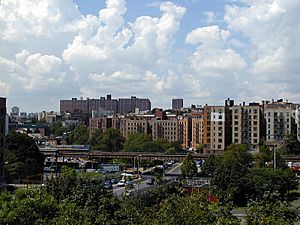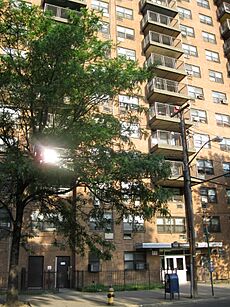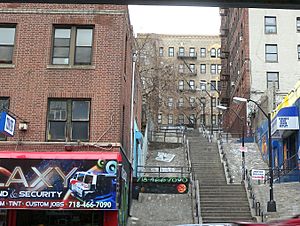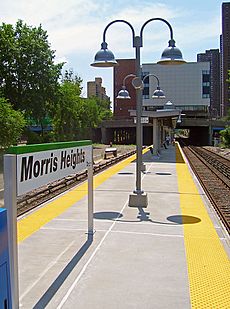Morris Heights, Bronx facts for kids
Quick facts for kids
Morris Heights
|
|
|---|---|
|
Neighborhood of the Bronx
|
|

Featherbed Lane, seen from Grand Concourse
|
|
| Country | |
| State | |
| City | |
| Borough | |
| Community District | Bronx 5 |
| Area | |
| • Total | 0.502 sq mi (1.30 km2) |
| Population
(2011)
|
|
| • Total | 36,779 |
| • Density | 73,260/sq mi (28,288/km2) |
| Economics | |
| • Median income | $24,850 |
| ZIP Codes |
10452–10453
|
| Area code | 718, 347, 929, and 917 |
Morris Heights is a lively neighborhood located in the West Bronx area of New York City. It's a mostly residential area, meaning many people live there.
The neighborhood has clear boundaries. To the north, you'll find West Burnside Avenue. Jerome Avenue is on its east side, and the Cross-Bronx Expressway forms its southern border. To the west, it's bordered by the Harlem River. University Avenue is a main street that runs through Morris Heights.
Morris Heights is part of Bronx Community Board 5. It uses the ZIP Codes 10452 and 10453. The local police department, the New York City Police Department's 46th Precinct, helps keep the area safe.
Contents
History of Morris Heights
Morris Heights has an interesting past. It was once home to a company called Gas Engine & Power Company & Charles L. Seabury Company. This company built ships right on the waterfront of Morris Heights. They started in 1896 and stayed there until after World War II, when they moved to City Island.
In the 1970s, many buildings in Morris Heights were damaged. The city then worked to fix up these buildings. They turned many old apartment buildings into affordable homes for people. New townhouses and apartment buildings have also been built on empty lots.
Many people believe that Hip Hop culture began right here in Morris Heights in the 1970s. During that time, disc jockeys (DJs) would host block parties in different parts of the Bronx. These parties helped shape the music and culture we know as hip hop today.
Who Lives in Morris Heights?
Morris Heights is home to about 36,779 people. Many families in the area receive public assistance to help with living costs. Most residents are of Hispanic or African American backgrounds. Most people living here rent their homes.
Based on the 2010 U.S. census, the combined population of University Heights and Morris Heights was 54,188. This was a small change from the year 2000. The area covers about 484 acres.
The people living in Morris Heights and nearby areas are diverse. About 64% are Hispanic or Latino. About 32% are African American. There are also smaller numbers of White, Asian, and Native American residents.
Most people in Community District 5, which includes Morris Heights, are young and middle-aged adults. About 28% are under 18, 29% are between 25 and 44, and 23% are between 45 and 64.
Land and Buildings
Morris Heights has many five- and six-story apartment buildings. You can also find older multi-unit homes and new townhouses. Some older buildings were damaged and later torn down. The total land area is less than half a square mile. The area has many hills, and special step streets help people walk between different elevations.
Public Housing in Morris Heights
There are ten New York City Housing Authority (NYCHA) housing developments in Morris Heights. These buildings provide homes for many residents.
- Harrison Avenue Rehab (Group A): One five-story building.
- Harrison Avenue Rehab (Group B): Four buildings, five and six stories tall.
- Macombs Road: Two buildings, five and six stories tall.
- Morris Heights Rehab: Three buildings, five and six stories tall.
- Sedgwick Houses: Seven buildings, 14 and 16 stories tall.
- University Avenue Rehab: Four six-story buildings.
- West Tremont Avenue-Sedgwick Avenue Area: One 12-story building.
- West Tremont Rehab (Group 1): Two buildings, five and six stories tall.
- West Tremont Rehab (Group 3): One five-story building.
- West Tremont Rehab (Group 2): Two six-story buildings.
Safety and Services
The New York City Fire Department (FDNY) helps keep Morris Heights safe. Engine Co. 43/Ladder Co. 59 is the local fire station.
Morris Heights has two United States Postal Service post offices nearby. They are the Morris Heights Station and the University Heights Station.
Education in Morris Heights
In Morris Heights, fewer adults have a college degree compared to other parts of New York City. However, students in Morris Heights and Fordham have shown good progress in school. The number of students doing well in math and reading has increased over the years.
Sometimes, elementary school students in Morris Heights miss more school days than the city average. For high school students, about 66% graduate on time.
Schools in the Neighborhood
Morris Heights has several public schools for students of all ages:
- PS 109
- PS 204: Morris Heights
- PS 226
- PS 274/IS 229: Roland N. Patterson
- PS 306
- PS 396/MS 390
- IS 303: The Leadership and Community Service Academy
- MS 232: The Academy School
- MS 331: The Bronx School of Science Inquiry and Investigation
- HS 365: The Academy for Language and Technology High School
Local Library
The New York Public Library (NYPL) has a branch in Morris Heights called the Sedgwick branch. It first opened in 1951 and moved to its current building in 1994. It's a great place for kids to find books and learn!
Getting Around Morris Heights
Morris Heights has many ways to get around using public transportation.
Bus Routes
Several MTA Regional Bus Operations bus routes serve Morris Heights:
- Bx3: Travels along University Avenue.
- Bx18: A loop route that uses Macombs Road.
- Bx32: Goes via Morris Avenue.
- Bx36: Travels along Tremont Avenue.
- Bx40: Uses 180th Street, Tremont, and Burnside Avenues.
- Bx42: Also uses 180th Street, Tremont, and Burnside Avenues.
Subway Stations
The New York City Subway has several stations that serve Morris Heights:
- 170th Street (4 train)
- Mount Eden Avenue (4 train)
- 176th Street (4 train)
- Burnside Avenue (4 train)
- 170th Street (B and D train)
- 174th–175th Streets (B and D train)
- Tremont Avenue (B and D train)
Train Service
The Metro-North Railroad's Hudson Line also has a stop in Morris Heights at the Morris Heights station. This train can take you to other parts of New York City and beyond.




